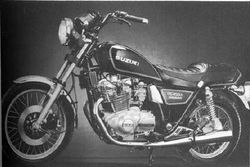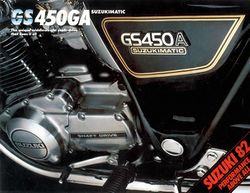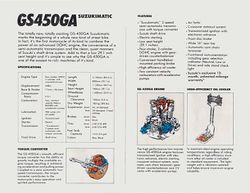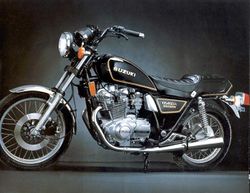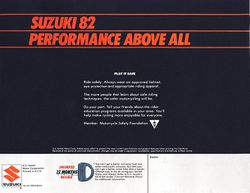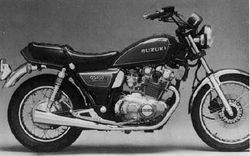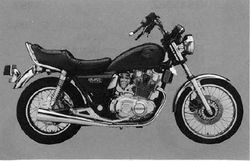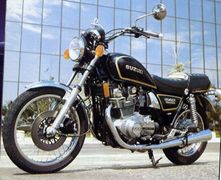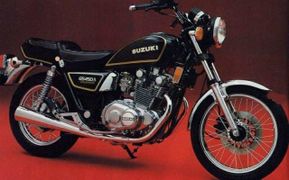Difference between revisions of "Suzuki GS450GA"
| (14 intermediate revisions by 4 users not shown) | |||
| Line 1: | Line 1: | ||
{{ | {{Motorcycle | ||
|name = Suzuki GS450GA | |name = Suzuki GS450GA Automatic | ||
| | |photo=Suzuki-gs450a-82.jpg | ||
|aka = | |aka = | ||
|manufacturer = | |manufacturer = Suzuki | ||
|parent_company = | |parent_company = | ||
|production = | |production = 1982 | ||
|model_year = | |model_year = | ||
|predecessor = | |predecessor = | ||
|successor = | |successor = | ||
|class = | |class = Standard | ||
|engine = | |engine = Four stroke, parallel twin cylinder, DOHC, 2 valves per cylinder. | ||
|bore_stroke = | |bore_stroke = | ||
|compression = | |compression = 9.0:1 | ||
|top_speed = | |top_speed = | ||
|power = | |power = | ||
|torque = | |torque = | ||
|ignition = | |fuel_system = | ||
|spark_plug = {{sparkplug|B8ES}} 82- | |ignition = Transistorized | ||
|battery = {{battery|YB12B-B2}} 82- | |spark_plug = {{sparkplug|NGK B8ES}} '82-83, '85-88<ref name="owners_1983">{{cite book|title=1983 Suzuki GS450GA Owners Manual|publisher=Suzuki|date=1983|url=https://www.cyclechaos.com/wiki/File:Suzuki_GS450GA_1983_Owners_Manual.pdf}}</ref> | ||
|transmission = | |battery = {{battery|YUASA YB12B-B2}} '82-83, '85-88 | ||
|frame = | |transmission = 2-speed [[automatic transmission|semi-automatic transmission]] | ||
|suspension = | |frame = | ||
|brakes = | |suspension =Front: 33mm Air assisted forks <br> | ||
Rear: Dual shocks | |||
|brakes =Front: Single 272mm disc <br>Rear: Drum | |||
|front_tire = {{tire|90/90-19}} '83 , '85-88<br />{{tire|3.60-18}} 82-83 , '85 | |front_tire = {{tire|90/90-19}} '83 , '85-88<br />{{tire|3.60-18}} 82-83 , '85 | ||
|rear_tire = {{tire|4.60-18}} 82-83 , '85<br />{{tire|120/90-16}} '83 , '85-88 | |rear_tire = {{tire|4.60-18}} 82-83 , '85<br />{{tire|120/90-16}} '83 , '85-88 | ||
|rake_trail = | |rake_trail = | ||
|wheelbase = | |wheelbase = | ||
|length = | |length = | ||
|width = | |width = | ||
|height = | |height = | ||
|seat_height = | |seat_height = | ||
|dry_weight = | |dry_weight = | ||
|wet_weight = | |wet_weight = | ||
|fuel_capacity = | |fuel_capacity = 12 Liters / 3.2 US gal / 2.6 Imp gal | ||
|oil_capacity = | |oil_capacity = 3.2L (3.4 US quart)<ref name="owners_1983">{{cite book|title=1983 Suzuki GS450GA Owners Manual|publisher=Suzuki|date=1983|url=https://www.cyclechaos.com/wiki/File:Suzuki_GS450GA_1983_Owners_Manual.pdf}}</ref> | ||
|fuel_consumption = | |recommended_oil=Suzuki ECSTAR 10w40 | ||
|turning_radius = | |fuel_consumption = | ||
|related = | |turning_radius = | ||
|competition = | |related = | ||
|competition = | |||
|final_drive=Shaft ‘82-83<ref name="wps_street_2019">{{cite book|title=2019 Western Power Sports Catalog|publisher=[https://www.wps-inc.com/catalogs Western Power Sports]|date=2019}}</ref> | |||
|manuals = [[:File:Suzuki GS450GA 1983 Owners Manual.pdf]] | |||
}} | }} | ||
The '''Suzuki GS450GA''' was a [[automatic]] [[motorcycle]] produced by [[Suzuki]] from 1982 to 1988. | |||
==Engine== | |||
The engine was a Air cooled cooled Four stroke, parallel twin cylinder, DOHC, 2 valves per cylinder.. The engine featured a 9.0:1 [[compression ratio]]. | |||
==Chassis== | |||
It came with a 3.60-18 front [[tire]] and a 4.60-16 rear tire. Stopping was achieved via Single 272mm disc in the front and a Drum in the rear. The front suspension was a 33mm Air assisted forks while the rear was equipped with a Dual shocks. The GS450GA Automatic was fitted with a 12 Liters / 3.2 US gal / 2.6 Imp gal fuel tank. | |||
== Overview == | |||
People who watched it happen with cars have been predicting for years that | |||
the motorcycle of the future will have an automatic transmission. It will also | |||
be enclosed, like all those failed designs of the future that most of us have | |||
forgotten or never seen. Anyone with a good crystal ball knows better, of | |||
course, but never mind. | |||
By now an automatic transmission on a motorcycle is not earthshaking. A | |||
novelty, perhaps, but not really new. It's been about six years since Moto Guzzi | |||
came out with the V-1000 Convert, followed by [[Husqvarna 420AF Automatic|Husqvarna's self-shifter]], the | |||
[[Honda CB750A|Honda 750 Automatic]] and the [[Honda CM400A|Honda CM400 Automatic]]. Now you can add Suzuki to the | |||
list of automatic motorcycles, with the '''GS450A'''. | |||
Like the other automatic transmission motorcycles (except the Husqvarna), the | |||
Suzuki doesn't have an automatic transmission. It has a hydraulic torque | |||
converter and a two-speed transmission, shifted with a lever on the left side of | |||
the engine, just like a normal motorcycle. It also has an engine very much like | |||
the normal GS450: DOHC twin, four valves, two carbs, good power and all the | |||
rest. Add to that a shaft drive, because this isn't a performance machine, it's | |||
a convenience machine. All these parts go into what looks like a GS450T, the | |||
traditionally-styled Suzuki Twin, with its wire spoke wheels, low stepped seat, | |||
teardrop gas tank and even such old-fashioned things as chromed fenders. It's a | |||
nice looking motorcycle. | |||
In concept it is easy enough to pull out a multiplate wet clutch on the | |||
normal 450 Suzuki and substitute a hydraulic torque converter. It's even easier | |||
to pull out a five-speed transmission and put in a two-speed. But the | |||
combination of changes that transformed the GS450 into the GS450A go beyond the | |||
abilities of any backyard mechanic. This is an entirely new motorcycle sharing | |||
fewer parts with its kin than would be expected. | |||
What has remained from the standard [[Suzuki GS450|GS450]] are the power-producing parts of | |||
the engine: cylinders, head, crankshaft, and all the connecting bits like cam | |||
chain, gear-driven counterbalancer and chain tensioner. Because of the shaft | |||
drive and different transmission, the engine cases are different from those of | |||
the normal 450. So are the camshafts, which have less duration and lift, the | |||
changes designed to increase low speed torque at the expense of peak power. | |||
On the standard 450, the dual overhead cams provide 280° of duration each, | |||
with 74° of overlap. Intake valve lift is 8.5mm, exhaust lift is 8mm. For the | |||
Automatic, intake duration is 256°, exhaust is 260°, overlap is 50° and lift is | |||
7.6mm on both. Torque peak is still 7000 rpm, but the maximum torque is about 25 | |||
lb.-ft., now, instead of the 27 lb.-ft. of the shifty 450. Below 7000 rpm the | |||
Automatic makes considerably more torque than the standard Suzuki, about 10 | |||
percent more from 4000 to 7000 rpm. That's the range where the torque converter | |||
engages, and the new cam timing makes it very engaging. | |||
Crankcases on the Automatic incorporate room for the gears transmitting power | |||
to the shaft drive. Within the cases are a number of oil system refinements that | |||
control oil pressure from the higher volume oil pump. Main bearings have three | |||
oil feed holes instead of two, a different rod bearing material is used, oil | |||
control jets below the cylinder and below the counterbalancer bearing inserts | |||
are used and the lower pan in the crankcase is tapped for lines running to the | |||
oil cooler. Maximum oil pressure in the Automatic is limited to 99 psi, up from | |||
the 71 psi limit of the standard 450. Other regulators maintain a relatively | |||
constant 24 psi to the torque converter. | |||
Oil flow and cooling is vital to the Automatic, because that's what makes the | |||
torque converter work. Suzuki's small torque converter, about the same size as a | |||
standard motorcycle multiplate clutch assembly, works just like the torque | |||
converter used in any automotive automatic transmission. In this case, the | |||
helical primary drive gear is bolted to the torque converter housing, with four | |||
coil springs on the driven gear absorbing deceleration shocks. Inside the | |||
housing, on the inboard side, is the pump impeller. Any time the engine is | |||
running the impeller is spinning, its angled blades flinging oil through a | |||
stator onto the turbine blades. When the engine is idling the pump throws the | |||
oil through the converter at very low pressure, not enough to move the turbine, | |||
which drives the main-shaft of the transmission. Turn the throttle so engine | |||
speed increases and oil is thrown faster and harder, guided by the angle of the | |||
impeller blades so torque is transmitted from the pump impeller to the turbine | |||
runner hard enough to spin the turbine and move the motorcycle. | |||
Until the engine is spinning near its torque peak, some of the oil scooped | |||
through the stator and hitting the turbine gets conducted back through the | |||
stator and helps drive the impeller again, making the torque converter more | |||
efficient. When the converter output shaft is spinning the same speed as the | |||
housing a one-way clutch on the stator allows it to spin so it doesn't absorb | |||
any energy. That's the lockup speed. If you held the back brake of the Suzuki | |||
on, put the transmission in drive and held the throttle wide open, the engine | |||
would speed up to a certain speed, about 3800 to 4100 rpm, where the drag | |||
of the torque converter equals the torque of the engine wouldn't spin | |||
any. That's the stall speed. | |||
Suzuki is expecting about a third of the Automatic owners will be women. | |||
Beginning riders of all kinds will make up most of the Automatic owners, and | |||
having a low seat height is important for ease of control, especially at the low | |||
speeds involved in learning to ride. | |||
Beyond that, the Automatic is an easy motorcycle to ride. It starts instantly | |||
with the choke lever on the left handgrip turned on. Suzuki has had carburetion | |||
difficulties on the other 450s, but the Automatic gets new 34mm Mikuni CV carbs | |||
with an accelerator pump that eliminates low speed stumbles. The bike idles well | |||
and has no carburetion difficulties. The torque converter helps here immensely. | |||
With the choke still on and the bike cold it can be nudged into gear and ridden | |||
away without concern. | |||
Of course starting is handled with a button and electric motor. There is no | |||
kickstarter. Ordinarily motorcycles without kickstarters can be bump started | |||
when the battery goes dead (when, not if), but the Automatic doesn't allow for | |||
bump starting. When the battery goes the bike doesn't go. | |||
The rest of the time the Automatic is marvelously easy to ride. Fire it up, | |||
click it in gear and twist the throttle. As simple as that, it moves. Twist the | |||
throttle more and it goes faster. Twist it the other way and it slows down. Pull | |||
or step on a brake and it slows down faster. There's none of this careful | |||
engagement of the clutch while matching engine speed with transmission speed. | |||
If the rider wants to click the lever up twice and leave the bike in high | |||
range, it will function as a single speed motorcycle, no shifting necessary. | |||
Ridden in just high range the Suzuki keeps up with traffic or even ahead of | |||
traffic if the throttle is twisted enough. Above 40 or 50 mph it starts to take | |||
hold and feel stronger, all the way up to the top of the 85 mph speedometer, | |||
where it runs out of steam. In high, it won't keep up with other motorcycles | |||
ridden hard. Faster acceleration calls for low range. | |||
Low range in the Suzuki is the surprise. Medium small motorcycles with | |||
automatic transmissions have been slow, and they feel especially sluggish. Not | |||
the Suzuki. Twist the throttle in low and the bike whisks you away without | |||
delay. It doesn't spin the tire or lift the front wheel, but you half expect it | |||
to. According to the marks on the speedometer (there is no tachometer), low | |||
range is good up to 50 mph. It will keep on accelerating up to about 60 in low, | |||
but high range works better. | |||
One of the few shortcomings of the bike occurs when it is shifted from low to | |||
high range under hard acceleration. Remember that the torque converter is still | |||
transmitting power, making it hard to shift. So you back off on the throttle and | |||
jam it into top gear, creating a loud clank as it pops into the next gear. Hard | |||
upshifts are noisy and require effort. Shift at 20 or 30 mph and it's relatively | |||
quiet and easy, but motorcycle-like acceleration is missing. | |||
Another shortcoming of the bike is easier to fix. When Suzuki substituted the | |||
torque converter for the clutch, the clutch lever remained. Only it's now | |||
connected to the back brake and has a pushbutton lock-lockout. The lever won't | |||
budge unless a button on the lever is pushed. That same button has to be pushed | |||
more to lock the lever in place once it's pulled nearly to the grip. As a | |||
parking brake it works fine. But a parking brake is seldom needed on the bike | |||
and having a non-moving clutch lever proved painful for riders who would | |||
occasionally forget it didn't have a clutch, grabbed the immovable lever and had | |||
a sore hand for the next week. The level can be removed easily, but it would b< | |||
better if Suzuki mounted the parking brake lever somewhere else. It could b( on | |||
the side of the bike or even on the back brake pedal, or anywhere i wouldn't be | |||
confused for something it' not. | |||
Like the other guys, the engineers at Suzuki are concerned that | |||
riders might hurt themselves somehow. So in addition to the parking brake, the | |||
Suzuki has a buzzer to warn the rider when the bike is in gear and the sidestand | |||
is down. The idea is that someone might leave the bike in gear, parked, and | |||
another person could twist the throttle and send the bike lurching off its | |||
stand. | |||
Some maintenance chores on the Suzuki aren't easy to do. Removing the rear | |||
tire, for instance, could hardly be more work. Even though this bike has a shaft | |||
drive and a drum rear brake, a combination that BMW has used to make the rear | |||
tire removable in about a minute, the Suzuki owner will need about half an hour, | |||
four wrenches, a pair of pliers, a big hammer and a friend. Because the mufflers | |||
are an inch too long, and positioned right where the axle has to be pulled, the | |||
shocks have to be disconnected or the exhaust removed in order to pull the axle | |||
and remove the rear wheel. | |||
Even removing the seat requires unbolting, unlatching and sliding it off | |||
hooks. There is no storage area anywhere under the seat like that found on the | |||
[[Suzuki GS450E|GS450E]]. | |||
Convenience and serviceability may not have improved, but the suspension has. | |||
The original GS450 suspension was soft in front and firm in back, the | |||
combination making the ride less than ideal and the handling mushy. Some owners | |||
experimented with smaller damping holes for more fork damping, which was some | |||
improvement, but the solution has now been provided by the factory. Spring and | |||
damping rates have been adjusted, though the U.S. Suzuki technical service | |||
people didn't have figures, so that the suspension is now well suited to the | |||
motorcycle. This Automatic exhibited none of the fork dive or imprecision in | |||
handling that afflicted the last 450 test Suzuki. Even the rear suspension did | |||
an above average job of handling solo riders or two-up without bottoming or | |||
riding harshly. All this comes from a suspension with no damping adjustments, | |||
but just air caps on the forks and preload adjustment on the rear suspension | |||
units. | |||
Brakes can similarly be described as excellent but undistinguished. There's | |||
nothing wrong with the braking performance of the bike. The single disc in front | |||
is strong and easily controlled, able to lock the front tire without excess | |||
lever pressure, while making control easy. And the rear drum is large enough to | |||
do its job without difficulty. For the speeds that can be generated by the | |||
Automatic there's no need for triple discs, and the forks control front end dive | |||
well enough without anti-dive hardware. | |||
In a way, the whole bike is like that. It does its job without excess or | |||
without difficulty. There are few technical fads on this bike. Handlebars are | |||
normal bent round tubes, inexpensive and effective and easily changed if they | |||
don't fit the rider. The wire-spoke wheels are light and strong and inexpensive. So far | |||
cast wheels are heavier than wire spoke wheels. Even performance falls in that | |||
good-but-not-great class. Yes, it's as fast in the quarter-mile as a Mazda RX7 | |||
or Datsun 280ZX. And it is easy to make it go fast with the torque converter | |||
automatically stepping up the effective gearing whenever the throttle is cranked | |||
open. | |||
Like other Suzukis, the operation of controls is unobtrusive. Nothing is | |||
stiff or difficult to use. Vibration is minimal, though more than the standard | |||
transmission GS450, due in part to lower than normal gearing. | |||
All of this makes the Suzuki GS450A more than a good beginner bike. After the | |||
beginner learns how to get the most performance out of the Automatic, he'll find | |||
himself with a startlingly good motorcycle that just happens to be enjoyable to | |||
ride | |||
Source Cycle 1982 | |||
==Specifications== | |||
{| class="wikitable" | |||
|- | |||
!Make Model | |||
|Suzuki GS 450GA Automatic | |||
|- | |||
!Year | |||
|1982 | |||
|- | |||
!Engine Type | |||
|Four stroke, parallel twin cylinder, DOHC, 2 valves per cylinder. | |||
|- | |||
!Displacement | |||
|448 cc / 27.3 cu in | |||
|- | |||
!Bore X Stroke | |||
|71 x 56.6 mm | |||
|- | |||
!Compression | |||
|9.0:1 | |||
|- | |||
!Cooling System | |||
|Air cooled | |||
|- | |||
!Induction | |||
|2 x 34mm BS34SS Mikuni carburetors | |||
|- | |||
!Ignition | |||
|Transistorized | |||
|- | |||
!Starting | |||
|Electric | |||
|- | |||
!Max Power | |||
|32.8 kW / 44 hp @ 9500 rpm | |||
|- | |||
!Max Torque | |||
|36.3 Nm / 3,7 kgf-m / 26.8 lb-ft @ 8000 rpm | |||
|- | |||
!Transmission | |||
|2 Speed constant mesh, automativic | |||
|- | |||
!Final Drive | |||
|Shaft | |||
|- | |||
!Front Suspension | |||
|33mm Air assisted forks | |||
|- | |||
!Front Wheel Travel | |||
|100 mm / 3.9 in | |||
|- | |||
!Rear Suspension | |||
|Dual shocks | |||
|- | |||
!Front Brakes | |||
|Single 272mm disc | |||
|- | |||
!Rear Brakes | |||
|Drum | |||
|- | |||
!Front Tire | |||
|3.60-18 | |||
|- | |||
!Rear Tire | |||
|4.60-16 | |||
|- | |||
!Wet-weight | |||
|197 kg / 434 lbs | |||
|- | |||
!Fuel Capacity | |||
|12 Liters / 3.2 US gal / 2.6 Imp gal | |||
|} | |||
{{clear}} | |||
==1982 GS450GAZ== | |||
[[Image:1982-Suzuki-GS450GAZ.jpg|left|thumb|1982 Suzuki GS450GAZ]] | |||
[[File:1982_GS450GA_US-sales1_800.jpg|left|thumb|1982 Suzuki GS450A Brochure]] | |||
[[File:1982_GS450GA_US-sales2_812.jpg|left|thumb|1982 Suzuki GS450A Brochure]] | |||
[[File:1982_GS450GA_US-sales3_810.jpg|left|thumb|1982 Suzuki GS450A Brochure]] | |||
[[File:1982_GS450GA_US-sales4_812.jpg|left|thumb|1982 Suzuki GS450A Brochure]] | |||
*V.I.N. #: JS1GL51K C 100001 | |||
*ENGINE PREFIX: L502- | |||
*ENGINE TYPE: 448cc [[Four-stroke]] Twin | |||
*MODEL CODE: 445 | |||
*COLOR: Blue, Black | |||
* 2-speed semi-[[automatic transmission]] | |||
* Gold tank stripes | |||
* [[Shaft drive]] | |||
{{clear}} | |||
==1983 GS450GAD== | ==1983 GS450GAD== | ||
[[Image:1983-Suzuki-GS450GAD.jpg|left|thumb|1983 Suzuki GS450GAD]]<br style="clear: left"/> | [[Image:1983-Suzuki-GS450GAD.jpg|left|thumb|1983 Suzuki GS450GAD]]<br style="clear: left"/> | ||
| Line 63: | Line 371: | ||
* Chrome rear grab rail | * Chrome rear grab rail | ||
* Chrome headlight mounts and housing | * Chrome headlight mounts and housing | ||
== Photos == | |||
<gallery mode='packed-hover'> | |||
File:Suzuki-gs450a-82.jpg|600px|Suzuki GS450GA Automatic | |||
File:Suzuki-GS-450A-82.jpg|600px|Suzuki GS450GA Automatic | |||
</gallery> | |||
==References== | |||
{{reflist}} | |||
{{Suzuki}} | {{Suzuki}} | ||
[[Category:Suzuki motorcycles]] | [[Category:Suzuki motorcycles]] | ||
[[Category:Automatic transmission motorcycles]] | |||
Latest revision as of 18:06, 3 December 2019
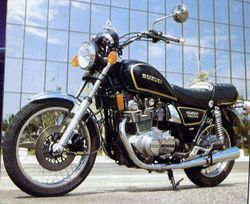 |
|
| Suzuki GS450GA Automatic | |
| Manufacturer | |
|---|---|
| Production | 1982 |
| Class | Standard |
| Engine | Four stroke, parallel twin cylinder, DOHC, 2 valves per cylinder. |
| Compression ratio | 9.0:1 |
| Ignition | Transistorized |
| Spark Plug | NGK B8ES '82-83, '85-88[1] |
| Battery | YUASA YB12B-B2 '82-83, '85-88 |
| Transmission | 2-speed semi-automatic transmission |
| Final Drive | Shaft ‘82-83[2] |
| Suspension | Front: 33mm Air assisted forks Rear: Dual shocks |
| Brakes | Front: Single 272mm disc Rear: Drum |
| Front Tire | 90/90-19 '83 , '85-88 3.60-18 82-83 , '85 |
| Rear Tire | 4.60-18 82-83 , '85 120/90-16 '83 , '85-88 |
| Weight | |
| Oil Capacity | 3.2L (3.4 US quart)[1] |
| Recommended Oil | Suzuki ECSTAR 10w40 |
| Fuel Capacity | 12 Liters / 3.2 US gal / 2.6 Imp gal |
| Manuals | File:Suzuki GS450GA 1983 Owners Manual.pdf More Manuals |
The Suzuki GS450GA was a automatic motorcycle produced by Suzuki from 1982 to 1988.
Engine[edit | edit source]
The engine was a Air cooled cooled Four stroke, parallel twin cylinder, DOHC, 2 valves per cylinder.. The engine featured a 9.0:1 compression ratio.
Chassis[edit | edit source]
It came with a 3.60-18 front tire and a 4.60-16 rear tire. Stopping was achieved via Single 272mm disc in the front and a Drum in the rear. The front suspension was a 33mm Air assisted forks while the rear was equipped with a Dual shocks. The GS450GA Automatic was fitted with a 12 Liters / 3.2 US gal / 2.6 Imp gal fuel tank.
Overview[edit | edit source]
People who watched it happen with cars have been predicting for years that the motorcycle of the future will have an automatic transmission. It will also be enclosed, like all those failed designs of the future that most of us have forgotten or never seen. Anyone with a good crystal ball knows better, of course, but never mind.
By now an automatic transmission on a motorcycle is not earthshaking. A novelty, perhaps, but not really new. It's been about six years since Moto Guzzi came out with the V-1000 Convert, followed by Husqvarna's self-shifter, the Honda 750 Automatic and the Honda CM400 Automatic. Now you can add Suzuki to the list of automatic motorcycles, with the GS450A.
Like the other automatic transmission motorcycles (except the Husqvarna), the Suzuki doesn't have an automatic transmission. It has a hydraulic torque converter and a two-speed transmission, shifted with a lever on the left side of the engine, just like a normal motorcycle. It also has an engine very much like the normal GS450: DOHC twin, four valves, two carbs, good power and all the rest. Add to that a shaft drive, because this isn't a performance machine, it's a convenience machine. All these parts go into what looks like a GS450T, the traditionally-styled Suzuki Twin, with its wire spoke wheels, low stepped seat, teardrop gas tank and even such old-fashioned things as chromed fenders. It's a nice looking motorcycle.
In concept it is easy enough to pull out a multiplate wet clutch on the normal 450 Suzuki and substitute a hydraulic torque converter. It's even easier to pull out a five-speed transmission and put in a two-speed. But the combination of changes that transformed the GS450 into the GS450A go beyond the abilities of any backyard mechanic. This is an entirely new motorcycle sharing fewer parts with its kin than would be expected.
What has remained from the standard GS450 are the power-producing parts of the engine: cylinders, head, crankshaft, and all the connecting bits like cam chain, gear-driven counterbalancer and chain tensioner. Because of the shaft drive and different transmission, the engine cases are different from those of the normal 450. So are the camshafts, which have less duration and lift, the changes designed to increase low speed torque at the expense of peak power. On the standard 450, the dual overhead cams provide 280° of duration each, with 74° of overlap. Intake valve lift is 8.5mm, exhaust lift is 8mm. For the Automatic, intake duration is 256°, exhaust is 260°, overlap is 50° and lift is 7.6mm on both. Torque peak is still 7000 rpm, but the maximum torque is about 25 lb.-ft., now, instead of the 27 lb.-ft. of the shifty 450. Below 7000 rpm the Automatic makes considerably more torque than the standard Suzuki, about 10 percent more from 4000 to 7000 rpm. That's the range where the torque converter engages, and the new cam timing makes it very engaging.
Crankcases on the Automatic incorporate room for the gears transmitting power to the shaft drive. Within the cases are a number of oil system refinements that control oil pressure from the higher volume oil pump. Main bearings have three oil feed holes instead of two, a different rod bearing material is used, oil control jets below the cylinder and below the counterbalancer bearing inserts are used and the lower pan in the crankcase is tapped for lines running to the oil cooler. Maximum oil pressure in the Automatic is limited to 99 psi, up from the 71 psi limit of the standard 450. Other regulators maintain a relatively constant 24 psi to the torque converter.
Oil flow and cooling is vital to the Automatic, because that's what makes the
torque converter work. Suzuki's small torque converter, about the same size as a
standard motorcycle multiplate clutch assembly, works just like the torque
converter used in any automotive automatic transmission. In this case, the
helical primary drive gear is bolted to the torque converter housing, with four
coil springs on the driven gear absorbing deceleration shocks. Inside the
housing, on the inboard side, is the pump impeller. Any time the engine is
running the impeller is spinning, its angled blades flinging oil through a
stator onto the turbine blades. When the engine is idling the pump throws the
oil through the converter at very low pressure, not enough to move the turbine,
which drives the main-shaft of the transmission. Turn the throttle so engine
speed increases and oil is thrown faster and harder, guided by the angle of the
impeller blades so torque is transmitted from the pump impeller to the turbine
runner hard enough to spin the turbine and move the motorcycle.
Until the engine is spinning near its torque peak, some of the oil scooped through the stator and hitting the turbine gets conducted back through the stator and helps drive the impeller again, making the torque converter more efficient. When the converter output shaft is spinning the same speed as the housing a one-way clutch on the stator allows it to spin so it doesn't absorb any energy. That's the lockup speed. If you held the back brake of the Suzuki on, put the transmission in drive and held the throttle wide open, the engine would speed up to a certain speed, about 3800 to 4100 rpm, where the drag of the torque converter equals the torque of the engine wouldn't spin any. That's the stall speed.
Suzuki is expecting about a third of the Automatic owners will be women. Beginning riders of all kinds will make up most of the Automatic owners, and having a low seat height is important for ease of control, especially at the low speeds involved in learning to ride.
Beyond that, the Automatic is an easy motorcycle to ride. It starts instantly with the choke lever on the left handgrip turned on. Suzuki has had carburetion difficulties on the other 450s, but the Automatic gets new 34mm Mikuni CV carbs with an accelerator pump that eliminates low speed stumbles. The bike idles well and has no carburetion difficulties. The torque converter helps here immensely. With the choke still on and the bike cold it can be nudged into gear and ridden away without concern.
Of course starting is handled with a button and electric motor. There is no kickstarter. Ordinarily motorcycles without kickstarters can be bump started when the battery goes dead (when, not if), but the Automatic doesn't allow for bump starting. When the battery goes the bike doesn't go.
The rest of the time the Automatic is marvelously easy to ride. Fire it up, click it in gear and twist the throttle. As simple as that, it moves. Twist the throttle more and it goes faster. Twist it the other way and it slows down. Pull or step on a brake and it slows down faster. There's none of this careful engagement of the clutch while matching engine speed with transmission speed. If the rider wants to click the lever up twice and leave the bike in high range, it will function as a single speed motorcycle, no shifting necessary. Ridden in just high range the Suzuki keeps up with traffic or even ahead of traffic if the throttle is twisted enough. Above 40 or 50 mph it starts to take hold and feel stronger, all the way up to the top of the 85 mph speedometer, where it runs out of steam. In high, it won't keep up with other motorcycles ridden hard. Faster acceleration calls for low range.
Low range in the Suzuki is the surprise. Medium small motorcycles with automatic transmissions have been slow, and they feel especially sluggish. Not the Suzuki. Twist the throttle in low and the bike whisks you away without delay. It doesn't spin the tire or lift the front wheel, but you half expect it to. According to the marks on the speedometer (there is no tachometer), low range is good up to 50 mph. It will keep on accelerating up to about 60 in low, but high range works better.
One of the few shortcomings of the bike occurs when it is shifted from low to high range under hard acceleration. Remember that the torque converter is still transmitting power, making it hard to shift. So you back off on the throttle and jam it into top gear, creating a loud clank as it pops into the next gear. Hard upshifts are noisy and require effort. Shift at 20 or 30 mph and it's relatively quiet and easy, but motorcycle-like acceleration is missing.
Another shortcoming of the bike is easier to fix. When Suzuki substituted the torque converter for the clutch, the clutch lever remained. Only it's now connected to the back brake and has a pushbutton lock-lockout. The lever won't budge unless a button on the lever is pushed. That same button has to be pushed more to lock the lever in place once it's pulled nearly to the grip. As a parking brake it works fine. But a parking brake is seldom needed on the bike and having a non-moving clutch lever proved painful for riders who would occasionally forget it didn't have a clutch, grabbed the immovable lever and had a sore hand for the next week. The level can be removed easily, but it would b< better if Suzuki mounted the parking brake lever somewhere else. It could b( on the side of the bike or even on the back brake pedal, or anywhere i wouldn't be confused for something it' not.
Like the other guys, the engineers at Suzuki are concerned that riders might hurt themselves somehow. So in addition to the parking brake, the Suzuki has a buzzer to warn the rider when the bike is in gear and the sidestand is down. The idea is that someone might leave the bike in gear, parked, and another person could twist the throttle and send the bike lurching off its stand.
Some maintenance chores on the Suzuki aren't easy to do. Removing the rear tire, for instance, could hardly be more work. Even though this bike has a shaft drive and a drum rear brake, a combination that BMW has used to make the rear tire removable in about a minute, the Suzuki owner will need about half an hour, four wrenches, a pair of pliers, a big hammer and a friend. Because the mufflers are an inch too long, and positioned right where the axle has to be pulled, the shocks have to be disconnected or the exhaust removed in order to pull the axle and remove the rear wheel.
Even removing the seat requires unbolting, unlatching and sliding it off hooks. There is no storage area anywhere under the seat like that found on the GS450E.
Convenience and serviceability may not have improved, but the suspension has. The original GS450 suspension was soft in front and firm in back, the combination making the ride less than ideal and the handling mushy. Some owners experimented with smaller damping holes for more fork damping, which was some improvement, but the solution has now been provided by the factory. Spring and damping rates have been adjusted, though the U.S. Suzuki technical service people didn't have figures, so that the suspension is now well suited to the motorcycle. This Automatic exhibited none of the fork dive or imprecision in handling that afflicted the last 450 test Suzuki. Even the rear suspension did an above average job of handling solo riders or two-up without bottoming or riding harshly. All this comes from a suspension with no damping adjustments, but just air caps on the forks and preload adjustment on the rear suspension units. Brakes can similarly be described as excellent but undistinguished. There's nothing wrong with the braking performance of the bike. The single disc in front is strong and easily controlled, able to lock the front tire without excess lever pressure, while making control easy. And the rear drum is large enough to do its job without difficulty. For the speeds that can be generated by the Automatic there's no need for triple discs, and the forks control front end dive well enough without anti-dive hardware.
In a way, the whole bike is like that. It does its job without excess or without difficulty. There are few technical fads on this bike. Handlebars are normal bent round tubes, inexpensive and effective and easily changed if they don't fit the rider. The wire-spoke wheels are light and strong and inexpensive. So far cast wheels are heavier than wire spoke wheels. Even performance falls in that good-but-not-great class. Yes, it's as fast in the quarter-mile as a Mazda RX7 or Datsun 280ZX. And it is easy to make it go fast with the torque converter automatically stepping up the effective gearing whenever the throttle is cranked open.
Like other Suzukis, the operation of controls is unobtrusive. Nothing is stiff or difficult to use. Vibration is minimal, though more than the standard transmission GS450, due in part to lower than normal gearing.
All of this makes the Suzuki GS450A more than a good beginner bike. After the beginner learns how to get the most performance out of the Automatic, he'll find himself with a startlingly good motorcycle that just happens to be enjoyable to ride
Source Cycle 1982
Specifications[edit | edit source]
| Make Model | Suzuki GS 450GA Automatic |
|---|---|
| Year | 1982 |
| Engine Type | Four stroke, parallel twin cylinder, DOHC, 2 valves per cylinder. |
| Displacement | 448 cc / 27.3 cu in |
| Bore X Stroke | 71 x 56.6 mm |
| Compression | 9.0:1 |
| Cooling System | Air cooled |
| Induction | 2 x 34mm BS34SS Mikuni carburetors |
| Ignition | Transistorized |
| Starting | Electric |
| Max Power | 32.8 kW / 44 hp @ 9500 rpm |
| Max Torque | 36.3 Nm / 3,7 kgf-m / 26.8 lb-ft @ 8000 rpm |
| Transmission | 2 Speed constant mesh, automativic |
| Final Drive | Shaft |
| Front Suspension | 33mm Air assisted forks |
| Front Wheel Travel | 100 mm / 3.9 in |
| Rear Suspension | Dual shocks |
| Front Brakes | Single 272mm disc |
| Rear Brakes | Drum |
| Front Tire | 3.60-18 |
| Rear Tire | 4.60-16 |
| Wet-weight | 197 kg / 434 lbs |
| Fuel Capacity | 12 Liters / 3.2 US gal / 2.6 Imp gal |
1982 GS450GAZ[edit | edit source]
- V.I.N. #: JS1GL51K C 100001
- ENGINE PREFIX: L502-
- ENGINE TYPE: 448cc Four-stroke Twin
- MODEL CODE: 445
- COLOR: Blue, Black
- 2-speed semi-automatic transmission
- Gold tank stripes
- Shaft drive
1983 GS450GAD[edit | edit source]
- V.I.N. # : JS1GL51K_D_100001
- ENGINE PREFIX: . . L502-
- ENGINE TYPE: . . . 448cc Four-stroke Twin
- MODEL CODE: . . . 445
- COLOR: Black & Silver, Two Tone Blue
- 2-speed semi-automatic transmission
- Shaft drive
1985 GS450GAF[edit | edit source]
- V.I.N. #: JS1GL51K F2100001
- ENGINE PREFIX: L502-
- ENGINE TYPE: 448cc Four-stroke Twin
- MODEL CODE: 445
- COLOR: Red
- Chrome rear grab rail
- Chrome headlight mounts and housing
Photos[edit | edit source]
References[edit | edit source]
- ↑ 1.0 1.1 1983 Suzuki GS450GA Owners Manual. Suzuki. 1983. https://www.cyclechaos.com/wiki/File:Suzuki_GS450GA_1983_Owners_Manual.pdf.
- ↑ 2019 Western Power Sports Catalog. Western Power Sports. 2019.
| |||||||||||||||||
